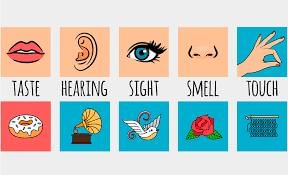What is descriptive writing? | Year 7 English (Cambridge) - Class 7 PDF Download
What is Descriptive Writing?
Descriptive writing is a style of writing that describes a person, place, scene, or thing in such a way that a vivid picture is formed in the reader's mind. It is written using the five senses: sight, sound, smell, taste, and touch. Descriptive writing often uses figurative language to enhance the imagery.

Using the Five Senses
When writing descriptively, it is important to engage the reader’s senses to create a vivid picture.
Here is how each sense can be used:
- Sight: Describe what you see, such as colors, shapes, sizes, and specific details.
- Sound: Mention the noises, whether they are loud, soft, harmonious, or discordant.
- Smell: Describe any scents or odors, which can be pleasant or unpleasant.
- Taste: If applicable, describe any tastes.
- Touch: Describe textures and sensations felt by touch.

Example Scene: A Busy City
Imagine a busy city. Let’s note down some important points:
- It’s a busy city.
- People are busy purchasing and talking.
- There are many cars all over.
- There are shops and billboards for advertisements.
- There’s a huge clock tower.
- It’s very noisy and congested.
Turning Points into a Descriptive Paragraph
Using the points above, we can create a descriptive paragraph.
Close your eyes and create an image in your mind as you read along:
Descriptive Paragraph
"This city is so crowded that there's no room for an apple to fall. People were bustling here and there. There are various types of shops with billboards and posters everywhere. People are driving cars or using public transport. It's a huge chaos. People are busy purchasing and wandering here and there. There is a clock tower as tall as a giraffe, and people can hear the honk and beep sounds from the cars all over. The tired roofs of buildings sagged down through the stores. The place was so congested that no other person could enter."
Creating the Image
Did you create a busy city with loads of cars, people, and shops in your mind? That’s exactly what the picture shows. Descriptive writing uses detailed observations and figurative language to help the reader visualize the scene.
Using Figurative Language
In the descriptive paragraph above, figurative language is used to create a more vivid image:
- Simile: "There is a clock tower as tall as a giraffe."
- Metaphor: "The tired roofs of buildings sagged down."
These figures of speech help create an image in your mind, making the description more vivid and engaging.
Conclusion
Now that we know all about descriptive writing, remember to use the five senses and figurative language to make your writing come alive. Descriptive writing is all about painting a picture with words, so be detailed and imaginative in your descriptions.
|
31 videos|12 docs|10 tests
|
FAQs on What is descriptive writing? - Year 7 English (Cambridge) - Class 7
| 1. What is descriptive writing? |  |
| 2. What are some key elements of descriptive writing? |  |
| 3. How can descriptive writing be effective in conveying a scene or setting? |  |
| 4. How can descriptive writing create a sense of atmosphere in a busy city scene? |  |
| 5. Why is descriptive writing important in bringing a scene to life for the reader? |  |





















